- What Are Red-Light Districts in Tokyo?
- Two Key Attractions of Tokyo’s Red-Light Districts
- 7 Famous Entertainment Districts in Tokyo
- Kabukichō (Shinjuku)|Tokyo’s Largest Entertainment District
- Yoshiwara (Taitō City)|Tokyo’s Most Iconic Soapland District
- Ikebukuro North Exit|Tokyo’s “Other” Kabukichō
- Shibuya|A Hub for Clubs and Love Hotels
- Roppongi|A District Packed with Bars and Clubs Popular Among Foreigners
- Ginza|An Upscale Social Hub of Luxury Clubs and Bars
- Akihabara|A Mecca for Otaku Culture Where Anime and Games Come to Life
- 5 Safety Tips for Enjoying Tokyo’s Entertainment Districts
- Things to Enjoy in Tokyo’s Red-Light Districts Besides Adult Services
- Enjoy Tokyo’s Entertainment Districts Responsibly
What Are Red-Light Districts in Tokyo?
Red-light districts in Tokyo refer to areas where adult entertainment businesses are concentrated,operating under the Entertainment Business Control Act (Fūeihō – Act on Control and Improvement of Amusement Business, etc.).
These districts are considered more specialized in adult-oriented entertainment compared to general entertainment areas, known as “kōrakugai,” which include restaurants, bars, and other leisure facilities.
For example, while Shinjuku’s Kabukichō is widely known as a general entertainment district, part of it functions as a red-light district, with host clubs and adult shops clustered in certain areas.
In contrast, areas like Yoshiwara are almost entirely dedicated to one type of adult industry.

Understanding this distinction is the first step toward accurately navigating Tokyo’s various red-light districts.
Two Key Attractions of Tokyo’s Red-Light Districts
The appeal of red-light districts in Tokyo isn’t limited to adult services alone.
In this section, we’ll explore two major reasons why these areas continue to attract people from all walks of life.
More Than Just Adult Services — A Full Range of Dining and Entertainment
One of the biggest attractions of Tokyo’s red-light districts lies in their diverse range of services that go far beyond adult entertainment.
Since many red-light districts are located within large entertainment zones, they are surrounded by restaurants serving exceptional food late into the night.
From sushi and yakiniku to casual local dishes enjoyed by workers after hours and highly rated ramen shops, the dining options are impressively varied.
In addition, the area is packed with large arcades, karaoke venues, and unique concept cafés.
Thanks to this variety, you can enjoy everything from dinner to after-parties and even third rounds of entertainment all in one place.

The true charm of Tokyo’s red-light districts lies in their ability to embrace a wide spectrum of desires with open arms.
Plenty of Photo-Worthy Spots
Another unique appeal of Tokyo’s red-light districts is their vivid, photogenic cityscape.
Step into these areas and you’ll be surrounded by bright red and blue neon signs, giant digital billboards, and a sea of storefront lights—creating a scene that feels like stepping into an otherworldly, cyberpunk world straight out of a sci-fi movie.
Especially on rainy nights, the reflections of neon lights on the wet asphalt amplify the chaotic, dreamlike atmosphere of these neighborhoods, adding a sense of surreal beauty.
From iconic landmarks like the arch of Kabukichō Ichiban-gai to the cluttered charm of narrow backstreets, everything becomes a visually striking subject for photography.

This extraordinary beauty itself becomes a form of high-quality entertainment.
7 Famous Entertainment Districts in Tokyo
Each red-light district in Tokyo has its own unique atmosphere and character.
Below, we introduce the key features of seven major areas that represent Tokyo’s adult entertainment scene.
Find the district that best matches your interests and what you’re looking for.
Kabukichō (Shinjuku)|Tokyo’s Largest Entertainment District

| Item | Details |
| Location | Kabukichō 1-chome to 2-chome, Shinjuku-ku, Tokyo |
| Nearest Stations | Shinjuku-Nishiguchi Station Seibu-Shinjuku Station Shinjuku-sanchome Station Shinjuku Station |
Kabukichō is known as “the city that never sleeps”, and is widely regarded as Japan’s number one entertainment district in both name and reality.
Just a step out of Shinjuku Station’s east exit brings you into a dazzling world of neon signs and an enormous welcome gate. Beyond it lies a maze of establishments from a wide range of industries, including.
- Restaurants
- Bars
- Karaoke lounges
- Movie theaters
- Host clubs
- Girls’ bars
- Adult entertainment venues
From major chain stores where first-timers and tourists can feel at ease, to underground spots known only to regulars, the area offers a remarkable variety.
Kabukichō’s true charm lies in its ability to welcome people from all walks of life.

If you want to truly experience Tokyo’s nightlife, start by soaking in the atmosphere of Kabukichō.
Yoshiwara (Taitō City)|Tokyo’s Most Iconic Soapland District
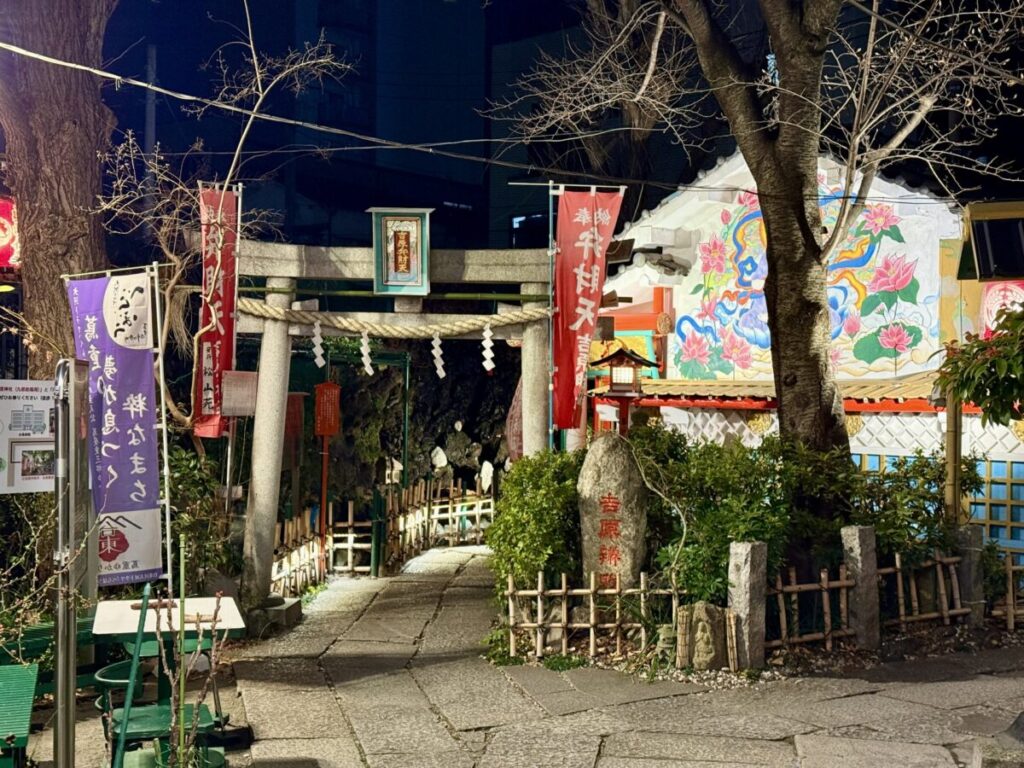
| Item | Details |
| Location | 4-chome, Senzoku, Taitō City, Tokyo |
| Nearest Stations | Minowa Station Iriya Station Asakusa Station Uguisudani Station Minami-Senju Station |
Yoshiwara is a district that traces its roots back to the Edo period, when it flourished as a licensed pleasure quarter under the Tokugawa shogunate. Today, it lives on as Japan’s largest district dedicated exclusively to soaplands.
Unlike the chaotic and diverse nightlife of places like Kabukichō, Yoshiwara is uniquely focused—nearly every business in the area operates as a soapland.
Because of this singular purpose, the streets have a quiet and somewhat tense atmosphere.
You’ll rarely find casual restaurants or shops where tourists can easily drop by for food or shopping.
The district is far removed from the noise and bustle of other entertainment areas, offering a sense of calm and a highly professional environment.

It’s a hidden gem, cherished by long-time regulars and those who visit with a clear understanding of its unique character.
Ikebukuro North Exit|Tokyo’s “Other” Kabukichō

| Item | Details |
| Location | 1-chome to 4-chome, Ikebukuro, Toshima City, Tokyo |
| Nearest Stations | Ikebukuro Station Kita-Ikebukuro Station Kanamechō Station |
This area is considered another major entertainment district that represents Tokyo, second only to Shinjuku’s Kabukichō.
In particular, the north exit of Ikebukuro Station is known for its even deeper, more chaotic atmosphere than Kabukichō—often described as being more suitable for seasoned visitors.
The area is characterized by a high concentration of delivery health (outcall escort) services and men’s relaxation spas tucked inside multi-tenant buildings.
In recent years, the number of authentic Chinese restaurants and grocery stores has surged, and the entire neighborhood now resembles a massive Chinatown.
Compared to Kabukichō, which has undergone redevelopment as a tourist-friendly destination, this district gives off a more raw, local vibe.

It’s recommended for more experienced visitors seeking a highly Asian, densely packed, and energetically charged experience.
Shibuya|A Hub for Clubs and Love Hotels
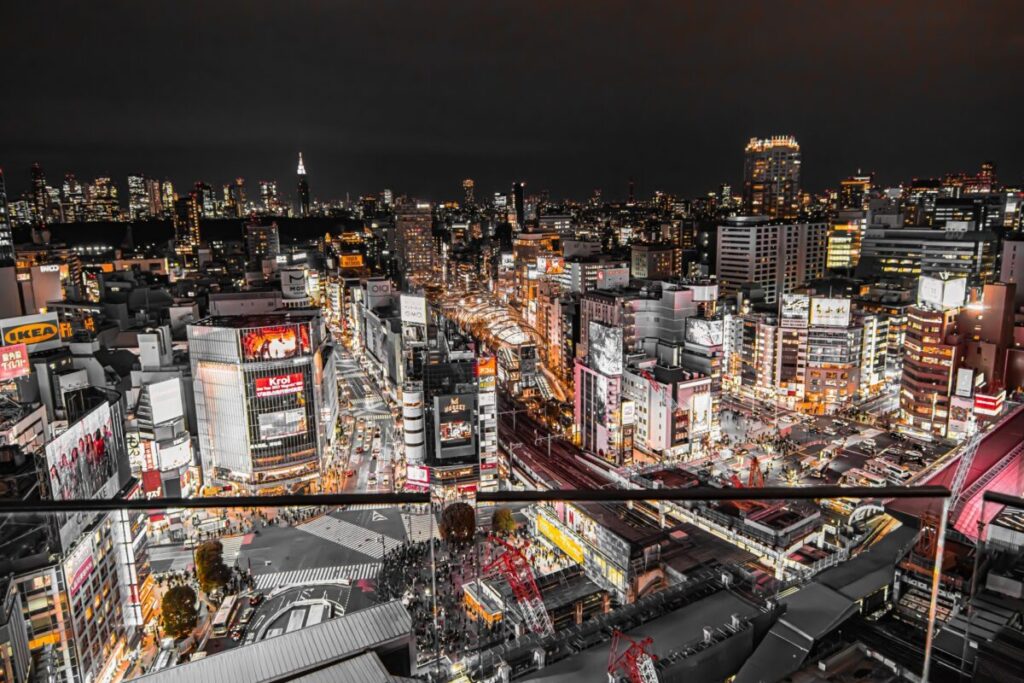
| Item | Details |
| Location | 1-chome to 4-chome, Shibuya, Shibuya City, Tokyo |
| Nearest Stations | Shibuya Station Shinsen Station |
Shibuya, known as a trendsetting hub for youth culture and fashion, takes on a completely different atmosphere once the sun sets.
At the heart of Shibuya’s nightlife are world-famous nightclubs, indie live music venues, and one of Japan’s largest concentrations of love hotels, stretching from Dogenzaka to Maruyamachō.
There’s a uniquely Shibuya vibe where music, fashion, and nightlife come together, as young people flow from the clubs and live houses straight into the love hotel district, riding the momentum of the night.

Unlike other entertainment districts, Shibuya’s nighttime identity is deeply shaped by the lifestyles and culture of its youth, making it a distinctive part of Tokyo’s after-dark scene.
Roppongi|A District Packed with Bars and Clubs Popular Among Foreigners
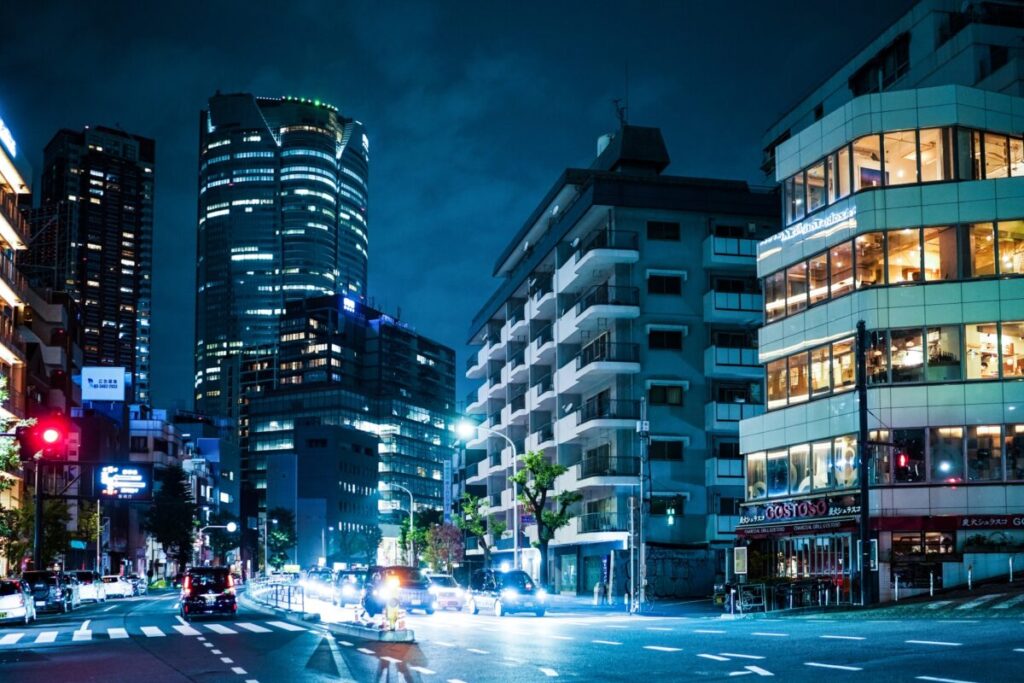
| Item | Details |
| Location | 1-chome to 7-chome, Roppongi, Minato City, Tokyo |
| Nearest Stations | Roppongi Station Roppongi-itchōme Station Nogizaka Station |
With many embassies and foreign companies based in the area, Roppongi is known as one of the best places in Tokyo to enjoy a truly international nightlife experience.
The district is home to numerous open, welcoming bars and large-scale nightclubs that cater to both foreign tourists and international residents.
You’ll also find “show pubs” offering extravagant performances and elegant cabaret clubs with sophisticated interiors—perfect for anyone looking to enjoy a highly entertaining night out.

A major advantage of Roppongi is the abundance of English-friendly venues, making it an ideal destination for those who want to enjoy the night without language barriers and connect with people from around the world.
Ginza|An Upscale Social Hub of Luxury Clubs and Bars
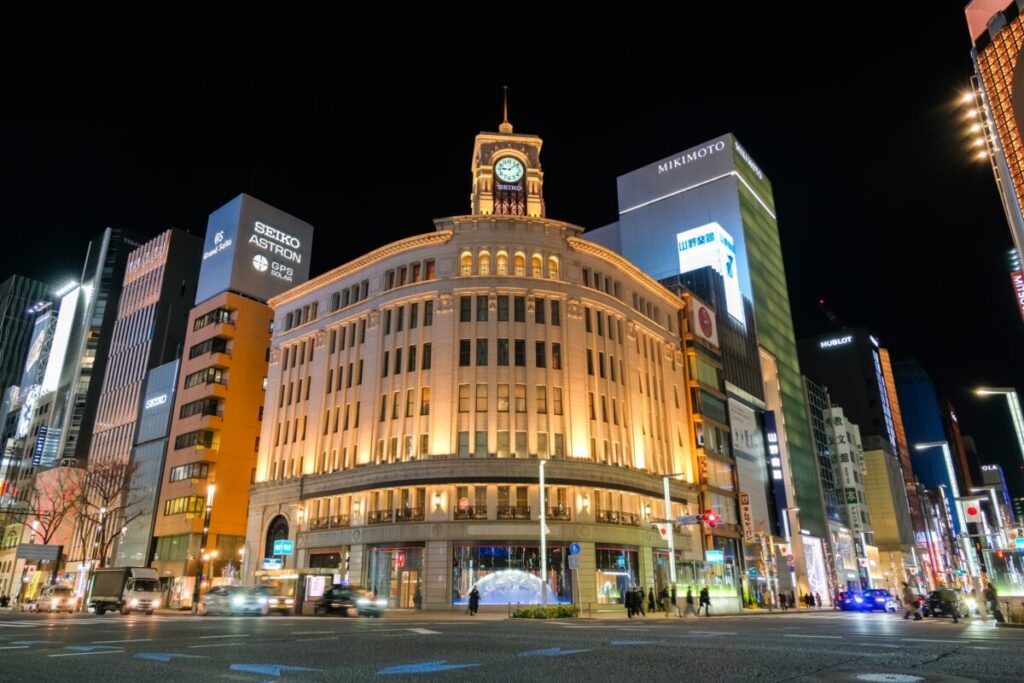
| Item | Details |
| Location | 1-chome to 8-chome, Ginza, Chūō City, Tokyo |
| Nearest Stations | Ginza Station Yūrakuchō Station Ginza-itchōme Station Hibiya Station Higashi-Ginza Station Kyōbashi Station Takarachō Station |
Ginza, known as Japan’s most prestigious luxury shopping district, also boasts a nighttime atmosphere that is equally refined.
Unlike other entertainment areas where neon lights blaze across the streets, Ginza offers a calm, elegant setting. Tucked away in quiet back alleys are exclusive members-only clubs and authentic bars frequented by top executives and politicians.
In Ginza, not just money, but also social status and personal connections are essential, and there are many venues where you won’t even be allowed entry without an introduction.
This isn’t just about drinking or entertainment—Ginza is truly a sophisticated social space for adults, where polished conversation and social standing are the main attractions.

With rules and a culture entirely different from other nightlife districts, Ginza feels like a world of its own.
Akihabara|A Mecca for Otaku Culture Where Anime and Games Come to Life
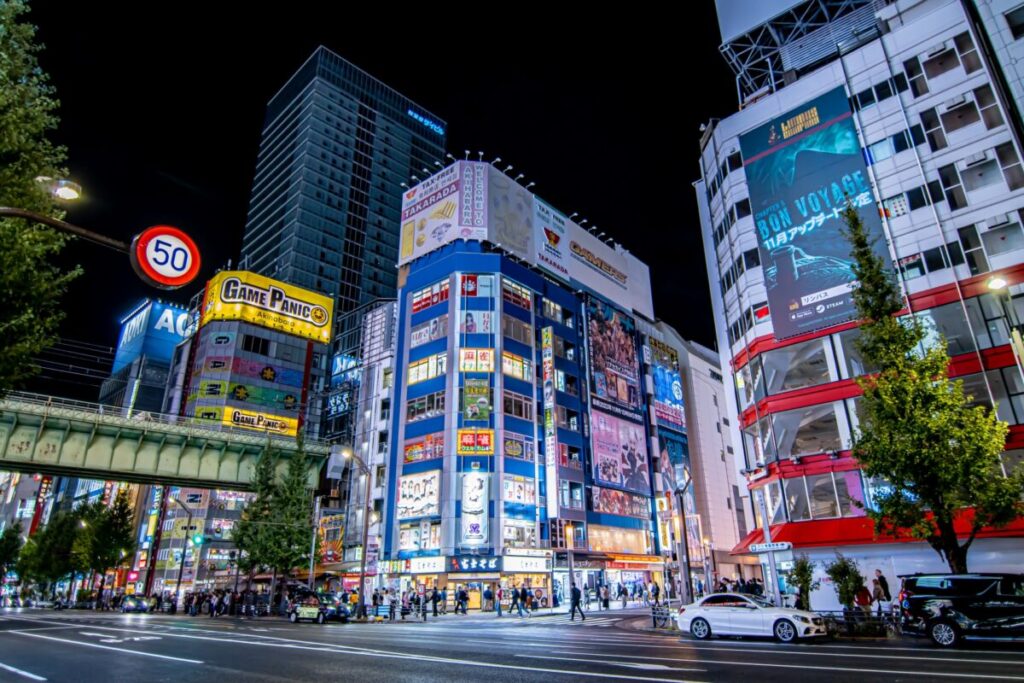
| Item | Details |
| Location | 1-chome to 6-chome, Sotokanda, Chiyoda City, Tokyo 1-chome to 4-chome, Kanda-Sakumachō, Chiyoda City, Tokyo Akihabara, Chiyoda City, Tokyo |
| Nearest Stations | Akihabara Station Iwamotochō Station Suehirochō Station Awajichō Station Ogawamachi Station Shin-ochanomizu Station Kanda Station Ochanomizu Station |
Known worldwide as a hub for electronics and as a sacred place for otaku culture, Akihabara has developed a uniquely unconventional red-light district of its own.
At the heart of Akihabara’s adult entertainment scene are establishments where guests can enjoy conversations and interactions with staff dressed as maids or anime characters.
These include “concept cafés” and “reflexology” parlors (known as “refle”), where the experience is themed around anime or video game worlds.
These businesses have evolved to fulfill the desires of a specific fanbase—those who seek to blur the line between fantasy and reality by immersing themselves in beloved fictional settings.
Unlike traditional adult services, these venues focus on “moe” (a feeling of affection toward cute characters) and emotional attachment, rather than physical intimacy.

It represents one of the most unique and modern forms of adult entertainment, born from Japan’s pop culture.
5 Safety Tips for Enjoying Tokyo’s Entertainment Districts
Tokyo’s red-light districts are exciting and full of unique charm—but to truly enjoy them, it’s essential to have the right knowledge to protect yourself.
By following these five basic safety tips outlined below, you can explore Tokyo’s nightlife with greater confidence and peace of mind.
Do Not Take Photos or Videos Inside the Venue
No matter what type of establishment you visit, you must never take photos or videos without permission.
This is considered one of the most basic forms of etiquette when enjoying Tokyo’s nightlife and forms the foundation of mutual trust.
These venues are private spaces for both the staff and other customers, and taking pictures without consent is a serious violation of their privacy.
Even if you only intend to photograph the interior decor as a memento, there is always the risk of accidentally capturing someone in the frame.
If you are caught taking photos, you may not only be asked to delete the data, but it could lead to serious trouble, including immediate removal from the premises or even fines.

To ensure that everyone can enjoy the experience comfortably, keep your smartphone or camera tucked away in your bag and refrain from any photography.
Choose Establishments with a Valid Entertainment Business License
As a basic rule for enjoying services safely, always choose venues that are officially licensed under the Act on Control and Improvement of Amusement Business, etc. (Fūeihō).
Such licensing ensures that the establishment operates within legal boundaries and serves as proof that it is under police supervision.
Licensed venues are legally required to display a permit plate issued by the Public Safety Commission in a clearly visible location, such as near the entrance.
On the other hand, if you don’t see a license displayed, there’s a high chance the business is operating illegally without a permit. This significantly increases the risk of problems such as unfair charges or failure to deliver promised services.

Make it a habit to check for a displayed permit before entering any venue.
Show Your ID Before Entering
Most adult entertainment establishments will ask to see photo identification upon entry to verify your age.
This is because the law strictly prohibits entry by anyone under the age of 18.
In fact, a venue that asks for ID is demonstrating that it operates legally and responsibly.
You should always carry official identification such as a passport, residence card, or driver’s license, and present it promptly if requested.
If a venue skips ID checks altogether, it’s likely they’re also ignoring other legal obligations and could pose serious risks.

Being asked to show ID is a key indicator that you’re choosing a safe and legitimate establishment.
Don’t Follow Street Solicitors
One of the most common causes of trouble in red-light districts is being lured by shady street solicitors and ending up the victim of a “bottakuri” scam—being charged outrageous fees.
In the first place, street solicitation itself is illegal and clearly prohibited under public nuisance prevention ordinances.
Solicitors may try to lure you in with tempting lines like “It’s cheap” or “The girl looks just like the photo,” butyou should never trust them.
Once you step inside the establishment, you may face aggressive demands for payment, along with high additional charges far above the originally quoted price.

No matter how enticing the offer may sound, stay firm, decline clearly, and walk away immediately.
Don’t Go Alone
Especially when visiting a red-light district for the first time or walking through unfamiliar areas late at night, it’s best to avoid going alone and instead stay in a group with trusted friends.
Being alone makes you an easy target for aggressive street solicitors or scouts, increasing the chances of being approached persistently.
In the event of a pricing dispute or a sudden health issue, having companions can help prevent the situation from escalating—they can act as witnesses or call for help if needed.

Traveling in a group not only enhances the fun, but also serves as a simple and effective safety net to protect one another.
Things to Enjoy in Tokyo’s Red-Light Districts Besides Adult Services
When people hear “red-light district,” they often imagine only adult-oriented services—but in reality, these areas offer much more.
From food and entertainment to cultural experiences, here are some fun and accessible activities anyone can enjoy in Tokyo’s red-light districts.
Late-Night Gourmet and Bar-Hopping Adventures
Tokyo’s entertainment districts are also known as a paradise for late-night food lovers—perfect for satisfying the appetites of those who never sleep.
Ramen shops bustling with hosts, bartenders finishing work, and partygoers looking to recharge create a uniquely electric atmosphere.
From rich, pork-based tonkotsu ramen to light and soothing salt-based bowls, it’s not uncommon to see long lines of people seeking the perfect bite to warm up after midnight.
Another must-try experience is bar-hopping through alleyways packed with tiny bars, such as in Shinjuku’s Golden Gai or Omoide Yokocho.

Food and drink in these districts offer more than just nourishment—they provide an immersive taste of the culture and soul of the nightlife itself.
Stay Out All Night at 24-Hour Arcades and Karaoke Boxes
Even if you miss the last train, you’ll never run out of ways to have fun in Tokyo’s entertainment districts.
One of the most popular options is spending time at massive 24-hour arcades and karaoke boxes.
In some buildings where every floor is dedicated to arcade games, you’ll find everything from the latest rhythm games and competitive fighting games to prize-filled UFO catchers—all running nonstop amid flashing lights and booming sound.
Meanwhile, karaoke boxes offer private rooms where you and your friends can sing freely and enjoy food and drinks without worry.
They’re the perfect place to either play through the night or take a break until the first train of the morning.

It’s a go-to course for experiencing Japan’s nightlife in a fun and energetic way.
Explore Deep Local Culture Through Concept Cafés and Small Theaters
In places like Akihabara’s maid cafés or Ikebukuro’s butler cafés, known as “concept cafés,” you can interact with staff members who fully embody specific themes or characters.
These exchanges allow for an extraordinary experience that feels as if you’ve stepped into the world of a story.
In addition to major theaters like Lumine the Yoshimoto, Shinjuku is also home to numerous small live venues where up-and-coming comedians hone their craft.
In such places, you might、discover a hidden gem of a future star—for just the price of a single coin.

Underground music shows and idol performances are held almost every night, offering a glimpse into Tokyo’s raw, vibrant culture—something you simply can’t find in typical tourist areas.
Late-Night Shopping at Mega Discount Stores
One of the most iconic landmarks in many of Tokyo’s nightlife districts is the 24-hour mega discount store Don Quijote.
Inside, you’ll find a maze of tightly packed shelves displaying everything from groceries and the latest electronics to luxury brand goods, cosmetics, and party supplies—making the store itself feel like an amusement park just to walk through.
In the late hours, the store becomes a lively melting pot of nightlife workers finishing their shifts, foreign tourists, and local youth, creating a unique, multicultural buzz.

If you need a break from the flashing neon lights of the red-light districts, a “treasure hunt” for quirky Japanese snacks or fun souvenirs can be one of the most enjoyable ways to spend your night.
Enjoy Tokyo’s Entertainment Districts Responsibly
In this article, we explored the definition and appeal of Tokyo’s red-light districts, seven major areas to visit, and key safety tips.
Each of these districts has its own unique culture and set of rules, offering a surprisingly deep and varied nightlife experience.
To fully enjoy their charm, it’s essential to respect the laws and follow the local rules.
In particular, never following street solicitors is a basic rule for protecting yourself and avoiding serious trouble.

With the right knowledge, a respectful attitude, and a strong sense of personal responsibility, you can safely and confidently explore Tokyo’s deep and fascinating nighttime world.
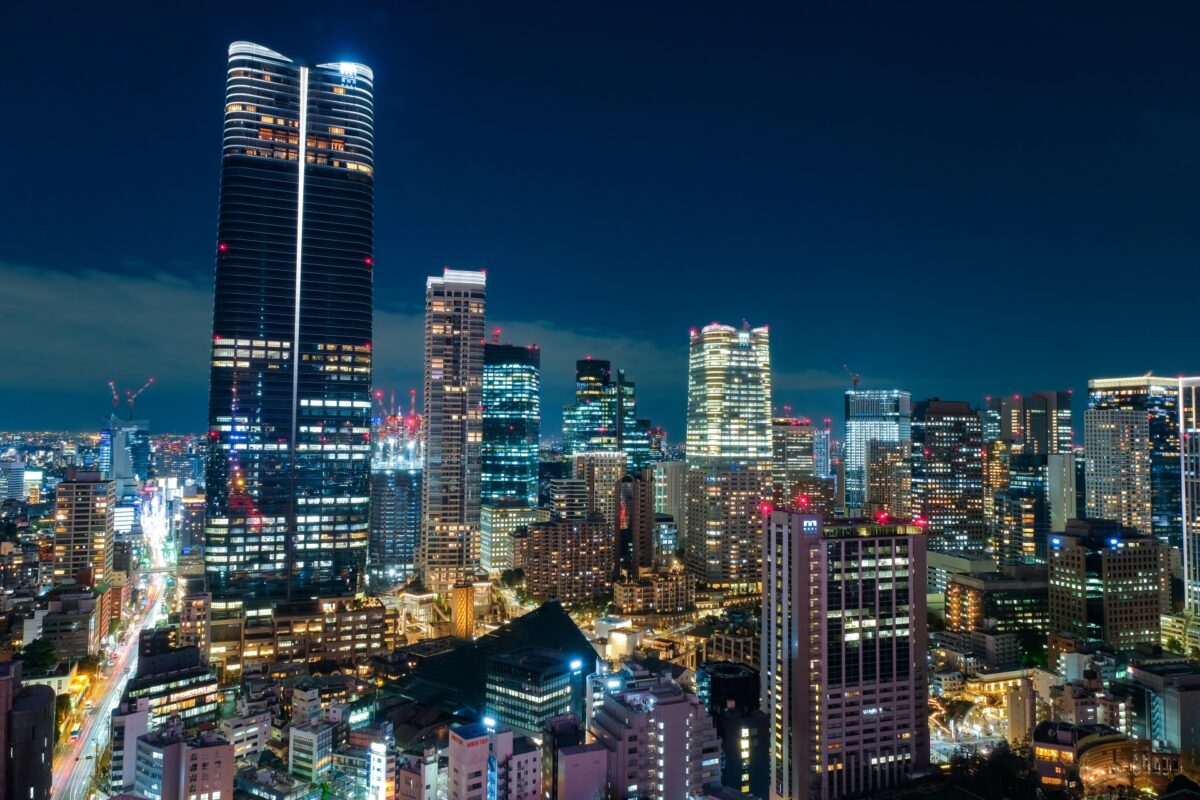



コメント